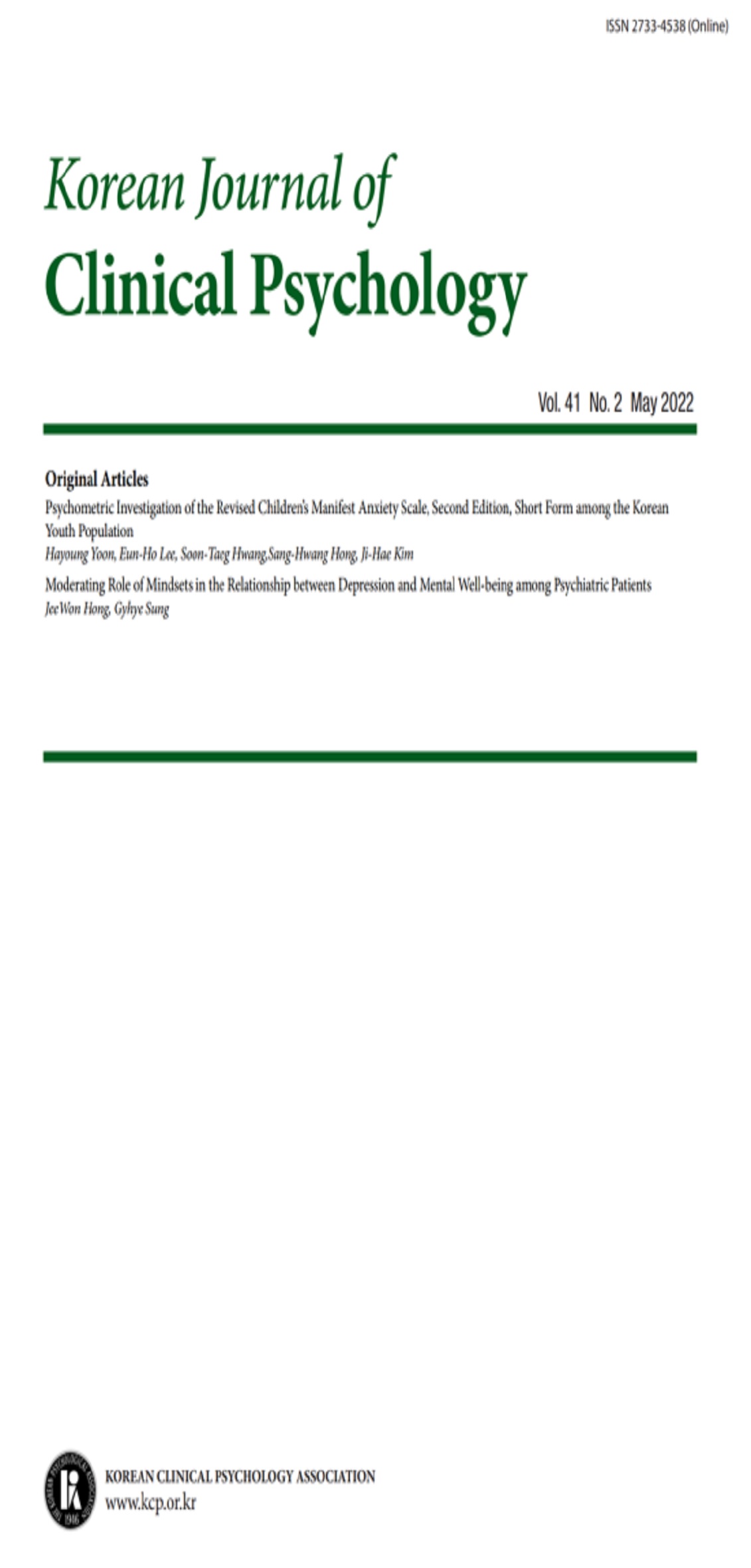open access
메뉴
open access
메뉴 E-ISSN : 2733-4538
E-ISSN : 2733-4538
본 연구는 Gresham과 Elliot(1990)의 Social Skill Rating System(SSRS)중 부모평정형(SSRS-P)이 우리나라 초등학생에게도 적절히 사용할 수 있는 도구인지 알아보기 위해서 실시되었다. 우리말로 번안한 초등학생용 사회 기술 평정 척도(K-SSRS-P)설문지를 학부모 892명에게 실시하고 여기서 얻은 자료를 이용하여 탐색적 요인분석과 공존타당도 검증을 실시한 결과, K-SSRS-P:초등학생용은 원 척도인 SSRS와 유사한 요인구조를 가지고 있는 것으로 제안되었으며, K-SSRS-P:초등학생용의 문제행동 척도는 K-CBCL의 문제행동 척도와 높은 수준의 유의미한 상관을 가지고 있는 것으로 나타났다. 2270명의 초등학생을 대상으로 한 확인적 요인분석 결과는 K-SSRS-P:초등학생용의 사회기술척도에서 얻어진 25문항 4요인 구조와 문제행동척도에서 얻어진 17문항 3요인 구조가 원척도인 SSRS의 요인구조를 동일하게 사용하는 경우보다 더 높은 수준의 적합도를 보이고 있음을 보여주었다. K-SSRS-P:초등학생용의 요인들 중 주장성 요인이 문제행동에 대해서 갖는 관계를 중심으로 한 우리문화 특유의 사회성 발달 양상과 개입에 대한 시사점등이 논의되었다
This study examined the reliability and validity of the Korean version of the Social Skill Rating System -Parent Form(SSRS-P; Gresham & Elliot, 1990) for elementary school students. In study 1, 892 parents of elementary students were administered with K-SSRS-P for the exploratory factor analysis(EFA), and 307 of them were administered with K-SSRS-P and K-CBCL to test the instrument’s concurrent validity. EFA yielded four interrelated factors of assertion, cooperation, responsibility and self-control in the social skill domain and three interrelated factors of hyperactivity, internalizing and externalizing in the problem behavior domain in the K-SSRS-P. The K-SSRS showed adequate internal consistency. Girls showed higher social functioning than boys did. Problem behavior scale showed significant and positive associations with K-CBCL. In study 2, 2270 parents of elementary students were administered with K-SSRS-P for the confirmatory factor analysis(CFA). CFA confirmed four factors structure of 25 items on the social skill scale and 3 factor structure of 17 items on the problem behavior scale in the K-SSRS-P and the results showed that the K-SSRS-P scores explained more variance in the data than the SSRS-P scores did. In conclusion, the K-SSRS is useful for assessing social skills in Korean elementary school students and has good psychometric properties. The implications of the cultural differences in social skills and the differential relationships of social skills to problem behaviors were discussed.
교육부 (2012). 학생 정서행동 발달 선별 검사및 관리 매뉴얼. http://www.mest.go.kr/web/285/ko/board/view.do?bbsId=48&mode=view&boardSeq=28324
국립국어원 (2008). 표준국어대사전. http:// stdweb2.korean.go.kr/main.jsp
김용석, 홍지영 (2007). 한국어판 아동용 사회기술 척도의 개발과 평가. 한국아동복지학, 24, 177-206.
문성원 (2002). 한국판 사회적 기술 척도의 타당도 및 유용성. 한국심리학회지: 상담 및심리치료, 14(3), 655-679.
문성원 (2003a). 한국판 청소년용 사회기술 평정 척도 I의 표준화: 신뢰도와 타당도 그리고 유용성. 한국심리학회지: 상담 및 심리치료, 15(2), 235-258.
문성원 (2003b). 한국판 청소년용 사회기술 평정 척도 II의 신뢰도, 요인구조, 준거관련타당도. 한국심리학회지: 발달, 16(4), 99-119.
문성원 (2013). 한국판 초등학생용 사회 기술평정척도(K-SSRS-S: 초등학생용)에 대한 타당화. 한국심리학회지: 임상, 32(1), 199-215.
박난숙 (1992) “Methylphenidate치료가 주의력결핍 과잉행동아의 인지․행동 및 사회,학습, 정서적 적응에 미치는 효과.” 연세대학교 대학원 석사학위논문.
오경자, 이혜련, 홍강의, 하은혜 (1997). K-CBCL 아동․청소년 행동 평가 척도. 중 앙적성출판사.
임효진 (2012). 사회적 행동이 읽기성장에 미치는 영향: 잠재집단 성장모형을 통합 종단연구자료 분석. 교육심리학연구, 26(1),199-224.
Achenbach T. M. (1991). Manual for the child Behavior Checklist/4-18 and 1991 Profile. Burlington, Vt: University of Vermont.
Achenbach T. M., Edelbrock C., Howell, C. T. (1983). Manual for Child Behavior Checklist and Revised Child Behavior Profiles. Burlington, University of Vermont.
Achenbach, T., & Edelbrock, C. (1987). Manual for the youth self-report and profile. Burlington. VT: Uniersity of Vermont Department of Psychiatry.
Brown, M. W. & Cudeck, R. (1993). Alternative ways of assessing model fit. In K. A. Bollen & J. S. Long (Eds.), Testing structural equation models (pp.136-162). Newbury Park, CA:Sage.
Cattell, R. B. (1966). The scree test for the number of factors. Multivariate Behavioral Research, 1, 245-276.
Caughy, M. O., Franzini, L., Windle, M., Dittus, P., Cuccaro, P., Elliott, M. N. & Schuster, M. A. (2012). Social competence in late elementary school: relationships to parenting and neighborhood context. Journal of Youth and Adolescence. 41, 1613-1627.
Demary, M. K., Ruffalo, S. L., Carlson, J., Busse, R. T., Olson, A. E., McManus, S. M., & Leventhal, A. (1995). Social skills assessment: A comparative evaluation of six published rating scales. School Psychology Review. 24(4). 648-671.
George, D., & Mallery, P. (2001). SPSS for windows step by step: A simple guide and reference 10.0 update(3rd ed.) Needham Heights, MA: Allyn & Bacon.
Gresham, F. M. & Elliot, S. N. (1990). Manual for the social Skills Rating System. American Guidance Service.
Hawkins, J. D., Kosterman, R. K., Catalano, R. F., Hill, K. G., Abbott, R. D. (2005). Promoting positive adult functioning through social development intervention in childhood. Archives of Pediatrics & Adolescent Medicine, 159(1), 25-31.
Horn. J. L. (1965). A rationale and test for the number of factors in factor analysis. Psychometrika, 30, 179-185.
Kaiser, (1960). The application of electronic computers to factor analysis. Educational and Psychological Measurement, 20, 141-151.
Kiley-brabeck, K., & Sobin, C. (2006). Social Skills and Executive Function Deficits in Children With the 22q11 Deletion Syndrome, 13(4), 258-268.
Kline, R. B. (2010). Principles and practice of structural equation modeling. New York; Guilford Press.
Lawson, C. (2003). Social skills and school. Center for Development and Learning. http://www.cdl. org/resource-library/articles/social_skills.php
Matson, J. L., Rotatory, A. F., & Helsel, W. J. (1983). Development of a rating scale to measure social skills in children: The Matson Evaluation of Social Skills with Youngster (MESSY). Behavior Research and Therapy, 21(4), 335-340.
Meyer, P. S. & Mueser, K. T. (2011). Resiliency in individuals with serious mental illness. In S. M. Southwick, B. T. Litz, D. Charney & M. J. Friedman(Eds.), Resilience and Mental Health: Challenges Across the Life Span(pp.281).
Reynolds, C. R., & Kamphaus, R. W. (2004). BASC-2 Behavior Assessment System for Children, Second Edition. Circle Pines, MN: AGS Publishing.
Kiley-Brabeck, K., & Sobin, C. (2006). Social Skills and Executive Function Deficits in Children With the 22q11 Deletion Syndrome. Applied Neuropsychology, 13(4), 258-268.
Wentzel, K. (1993). Does being good make the grade? Social behavior and academic competence in middle school. Journal of Educational Psychology, 85(2), 357-364.
